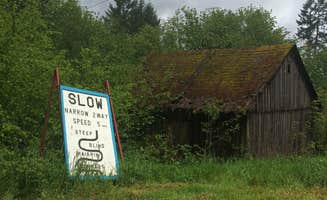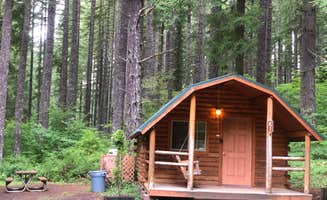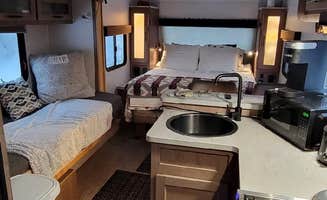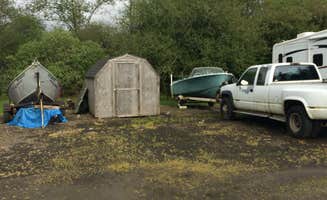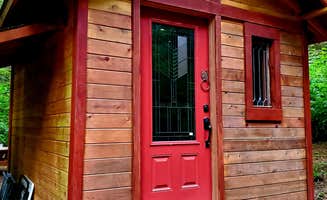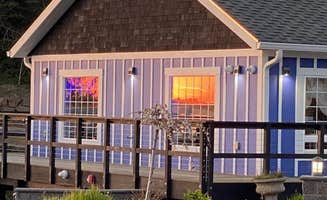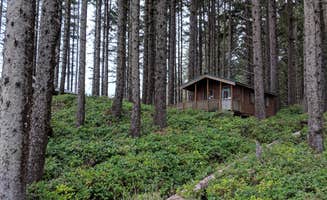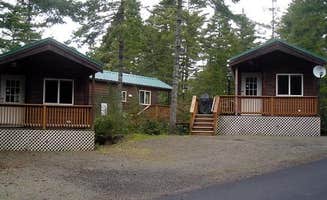Tillamook State Forest offers glamping options within a 40-mile radius of Portland, making it accessible for weekend getaways. The forest sits at elevations ranging from 750 to 1,200 feet above sea level, creating varied microclimates throughout the camping areas. Seasonal temperatures vary significantly with summer averages of 75-85°F during the day and cooler 45-55°F nights.
What to do
Swimming in forest creeks: Trask River County Park features several swimming spots perfect for cooling off. "Great swimming holes!!" notes Branden T., highlighting the peaceful river sounds that accompany the experience.
Hiking accessible trails: L.L. Stub Stewart Memorial State Park offers multiple trail options for all skill levels. "Lots of hiking and biking trails within the park and a regional rail to trail runs through it," shares Annie B., emphasizing the variety of outdoor activities available.
Disc golf courses: Paradise Point State Park provides an unexpected recreational opportunity. "The selling point for this camp ground was the disc golf course," explains Fatima H. The course offers a unique activity when you need a break from typical camping pursuits.
Beach exploration: When staying near the coast, investigate tidepools and marine environments. "The beach is only a five minute walk away," comments smittie about Nehalem Bay, making it convenient to alternate between forest and coastal environments.
What campers like
Privacy between sites: At Nehalem Falls Campground, campers appreciate the secluded feel. "The tent sites are very private and right on the Nehalem River which is warm enough to swim in," notes Spencer C., highlighting how the layout enhances the camping experience.
Group camping options: Camp Wilkerson accommodates larger parties with specialized facilities. "The group camping areas have lean to that can accommodate many people in the bunks," explains Don H., making it ideal for family reunions or organized group outings.
Seasonal wildlife viewing: Early risers might spot local animals. "If you're lucky enough you will wake up to elk grazing in the grassy areas," mentions Savannah S. about Trask River County Park, adding an unexpected wildlife viewing opportunity.
Waterfront access: Many campgrounds feature direct water access. "Each site has a picnic table. There are pit toilets and a water point," describes Stephanie Z. about Brooke Creek Hike-in Camp, showcasing the basic amenities alongside natural features.
What you should know
Limited cell service: Most forest campgrounds have no connectivity. "You will have no service whatsoever up at the campground but that's what camping is for, to enjoy your time outdoors!" advises Savannah S. about Trask River County Park.
Campground filling patterns: Popular sites fill quickly, especially in summer. "This campground was featured on an outdoor show a couple of years ago and has been full ever since," reveals Chad L. about Nehalem Falls Campground, suggesting early arrival or weekday visits.
Toilet variations: Facilities range from vault toilets to modern restrooms. "The lower bathroom is old and needs updated... The upper bathrooms are amazing and worth the walk near the horse camp," reports Schona K. about Camp Wilkerson, highlighting facility differences within the same campground.
Highway proximity: Some campgrounds experience road noise. "Freeway is really really close to the whole camp site. You can hear vehicles at night," warns Susan P. about Paradise Point State Park, which might affect light sleepers.
Tips for camping with families
Look for dedicated youth areas: Champoeg State Heritage Area offers family-friendly amenities. "Great biking trails that are kid friendly. There lots of historical sites around the campground to enjoy as well," says Scott W., pointing out educational opportunities alongside recreation.
Consider yurts for shoulder seasons: Heated accommodations extend the camping season. "The yurts are heated, and a couple of them are pet friendly, which is great for us!" shares Lana N. about Champoeg, offering a comfortable alternative when tent camping might be too cold.
Choose campgrounds with play areas: Kid-specific features keep younger campers engaged. "It's nice to disconnect from cell phones," mentions Stacie H. about Trask River Park, emphasizing the family bonding potential.
Seek campgrounds with bike loops: Safe cycling areas work well for families. "Nice paved loop for kids to ride bikes," notes C M. about Nehalem Bay, providing contained recreation options away from vehicle traffic.
Tips from RVers
Site accessibility considerations: Cape Lookout State Park requires careful navigation for larger vehicles. "We personally prefer the A and B loops which are closest to the beach and feel like they have the most privacy," advises Nathan R., helping RVers choose the most suitable locations.
Hookup locations vary: Check utility placement before setup. "The water and sewer hookups were in the middle of the site, with electric being at the back of the pad," explains MickandKarla W. about L.L. Stub Stewart Memorial State Park, noting "The water pressure was not very good at around 35 psi."
Size restrictions apply: Many forest campgrounds cannot accommodate large rigs. "Spaces are fairly small so no campers over 25ft I'm guessing," warns Patrick S. about Gales Creek Campground, setting clear expectations for vehicle limitations.
All-season availability: Some campgrounds remain open year-round. "Went tent camping. Was expecting a bit more of a campsite, but it was just a big field with everybody together," shares Erin P., suggesting off-season visits might provide more space despite simpler setups.



